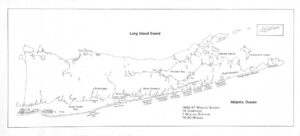Howell Family and the Whaling Industry
Whaling was a very important part of the early American economy and was a thriving coastal industry. However, whales were used by humans even before Europeans arrived. On Long Island, Algonquian natives from the Shinnecock and Montaukett tribes used beached whales for spiritual ceremonies. The Shinnecock and Montaukett tribes used the fins and tails of the whale for these ceremonies even after Long Island was settled by the English. In the 1650s, John Ogden and John Cooper were the first Englishmen to introduce the process of commercial whaling to Long Island.
The Howell family’s involvement with whaling on Long Island truly begins with John, Edward Jr., and Richard Howell who were the sons of Edward Howell. In 1670, Major John Howell and Josiah Laughton entered the first two whaling contracts on Long Island. It was during this period that commercial whaling really took off and became an extremely profitable business. The main whale species hunted at this point was the North Atlantic right whale. An adult right whale generally yielded anywhere from 30 to 50 barrels of oil. In addition to the oil, baleen was also harvested from the whales and used to make the bone in corset stays, buggy whips, and many other everyday items. This species swam on the Long Island shore from November to March. Whales quickly began to become scarce in shore and captains were forced to venture further out to continue hunting them. This form of “boat whaling” continued until the decline of the industry. Today, the North Atlantic right whale is considered highly endangered.

Dankers, Jasper. Drawing depicting North Atlantic Right Whales off New York Harbor. 1679-80. Location unknown.
Most of the first Englishmen on Long Island were farmers and knew nothing about whaling. That is why Shinnecock and Montaukett natives were contracted by ship owners to work as whalers serving under an English captain. Being a whaler brought more status to an individual in the native community than farming or fence building did due to the highly dangerous labor and more appealing profits. In 1676, a Shinnecock native named Artor, signed onto Richard Howell and Joseph Fordham’s new whaling company along with 16 other Shinnecock men for two seasons. However, debts incurred while whaling was a consistent issue that plagued whaling crews. Often, if no whales were caught, the crew did not get paid. In addition to no guaranteed wages, the captains and ship owners were not obligated to provide the crew with food or drinks, and therefore, provisions were often credited out and at the end of a season the whaler would pay their debts. Some crews did not get free lodging and were charged fees and fines for the equipment they used or possibly damaged. Through these debts, the ship owners were able to keep crewmen longer since a whaler could not leave the company until his debt was paid. This was the case with Artor, who tried to leave Richard Howell and Joseph Fordham’s company after two seasons to work for Edward Howell Jr., however, Fordham made him return to work until his debt was paid. Artor wrote that “I Artor Indian belonging to the Shinnecock within the town of Southampton on Long Island, being indebted to Joseph Fordham of Southampton a considerable sum of money upon the [illegible] whaling expended by him. I not knowing how to make satisfaction for the said debt, do voluntarily of my own accord engage and promise to go to sea a whaling for the said Fordham, from time to time and year to year, attending all opportunities every whale season of going to sea, for the procuring of whales or other great fish…until I have fully satisfied and paid the said debt.” (Southampton Town Archives, Liber A2: 133). Artor paid off his debt in three seasons and signed on with James Cooper for the 1681-82 season. Shinnecock and Montaukett whalers often moved from company to company every season trying to find better working terms. This demonstrates the small amount of independence that the natives were able to express.

Dennis, Jeremy. Map showing Whaling Stations along the south shore of Long Island and number of whales taken in 1687. Date unknown. Shinnecock Indian Nation, Southampton, New York.
Whaling company owners had a significant amount of power and influence within the community. One example of this was with Governor Andros in 1670s. John Cooper died in 1677 and his wife, Sarah, tried to maintain his whaling business. She wrote to Governor Andros twice that some of the natives who she claimed her husband had already paid, had breached their contracts and signed on to work for Richard Howell and Joseph Fordham’s company. Governor Andros did not respond to her because he had recently had a legal quarrel with Major John Howell and Joseph Fordham and probably did not want to challenge such influential families again. Nevertheless, Richard Howell and Joseph Fordham proved that they had hired the Shinnecock’s legally.
The American Revolutionary War caused a temporary stop in the whaling industry due to the British occupation of New York City and Long Island and the naval blockades. However, after the war ended whaling resumed and a new industry emerged in the relatively new port of Sag Harbor. Shipbuilding was a major aspect of Sag Harbor from the late 18th century to the early 19th century. Coastal in shore boats had previously been constructed there, however after the American Revolutionary War, larger “ocean going” ships were being built. This was due to most whaling ships going to the coast of Brazil or Greenland after the 1770s. Captain Stephen Howell owned many ships that were built in Sag Harbor that shipped goods and served as whaling ships. The Nancy was a 45-ton sloop built at Sag Harbor in 1792. It was owned by Jeremiah Rogers, Stephen Howell, and Thomas Beebe. The sloop Nabby was built in 1793 for Stephen Howell, Jeremiah Rogers, and Luther Hildreth. The Abigail was a 215-ton ship that was the first vessel to be rebuilt at Sag Harbor for whaling. This rebuild took place in 1795 and the ship was owned by Stephen Howell, Silas Howell, and Lewis Howell. Stephen Howell initially sailed this ship, but a Captain Fowler was later made the ship’s captain. The Abigail made four whaling voyages and it was ultimately sold to a whaling company in Nantucket. In 1800, the Nancy, a 129-ton brig was built in Sag Harbor and was owned by Thomas Beebe, Stephen Howell, Silas Howell, and Lewis Howell. The Nancy was later enlarged to 200 tons, however, it wrecked on the coast of Cape Cod a few years later. Stephen Howell also had a ship built in 1806 near East Hampton, however, not much is known about this vessel. The War of 1812 resulted in yet another pause in business, but after the end of the war, whaling resumed.
Sag Harbor was most prosperous from 1837 to 1847, with 1845 being its peak year. In 1845, 64 whaling ships were in its fleet, however, in 1850 there were only 24 ships. Sag Harbor was one of the Nation’s leading whaling towns (Nantucket and New Bedford were the only ones that were more successful). This era of prosperity would be short-lived. The discovery of petroleum meant that whale oil would gradually become obsolete. North Atlantic whale oil companies were now competing with Pennsylvania oil companies. The California Gold Rush was another event that significantly contributed to the decline of the whaling industry. Many of the men who had been whalers, left the East coast for the West to try to get rich off the promises of gold. This resulted in a large decrease of laborers in the whaling industry. By 1850, most of the old whalers had retired, and by the 1870s the whaling industry was at its close. The whaling business created jobs that covered all aspects of the industry and led to the economic and commercial growth of the Northeast coast from the colonial period to the Gilded Age. However, this industry created lasting negative impacts on the North Atlantic whale population and further established the principle of English exploitation of resources and people.
Worked Cited
Adams, James Truslow. History of the Town of SOUTHAMPTON: East of Canoe Place. Filmed by the Genealogical Society of Utah, 1993, https://www.google.com/books/edition/History_of_the_Town_of_Southampton_east/2edYAAAAMAAJ?hl=en&gbpv=0, Accessed 15 Sept. 2021.
Dankers, Jasper. “Drawing Depicting North Atlantic Right Whales off New York Harbor.” Indian Whalers on Long Island, 1669-1746, Long Island History Journal , https://lihj.cc.stonybrook.edu/2016/articles/indian-whalers-on-long-island-1669-1746/#_edn51. Accessed 15 Sept. 2021.
Doctorow , Richard. “Sag Harbor Whaling Tales .” Whalebone, Whalebone , 4 Aug. 2016, https://whalebonemag.com/whaling-sag-harbor/.
Hazelton, Henry Isham. The Boroughs of Brooklyn and Queens, Counties of Nassau and Suffolk, Long Island, New York, 1609-1924. Lewis Historical Pub. Co., 1925, https://books.google.com/books?id=8swpAQAAMAAJ&dq=stephen+howell+ship+1806&source=gbs_navlinks_s, Accessed 15 Sept. 2021.
“History.” History | Sag Harbor, NY, Village of Sag Harbor, New York , https://www.sagharborny.gov/101/History.
Howell, George Rogers. The Early History of Southampton: L.i., New York, with Genealogies. Rev., Corr. and Enl. Weed, Parsons and Co., 1887, https://books.google.com/books?id=S5M5AQAAMAAJ&printsec=frontcover&source=gbs_ge_summary_r&cad=0#v=onepage&q&f=false, Accessed 15 Sept. 2021.
Sleight, Harry D. Sag Harbor in Earlier Days: A Series of Historical Sketches of the Harbor and HAMPTON PORT. Printed by the Hampton Press, 1930, Seeking My Roots, https://www.seekingmyroots.com/members/files/H008635.pdf, Accessed 15 Sept. 2021.
Strong , John A. “Indian Whaler on Long Island, 1669-1746.” Indian Whalers on Long ISLAND, 1669-1746, Long Island History Journal , https://lihj.cc.stonybrook.edu/2016/articles/indian-whalers-on-long-island-1669-1746/#_edn51.
Working Sag Harbor. Sag Harbor Partnership, https://www.sagharborpartnership.org/working-sag-harbor.html.


